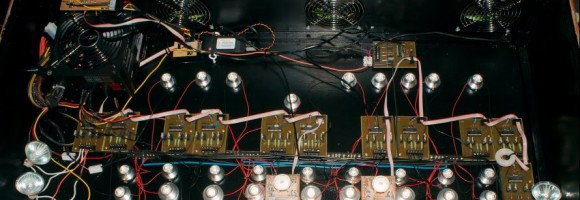Paludarium 2.0 is going to utilize the same lighting system as the current (1.0) version. Because I am often asked about this technology, I decided to translate my original post (see Verlichting van het paludarium (in Dutch) and post it here.
Lighting hood
On top of the Paludarium a lighting hood will be built. This is a rather high unit (+-25cm) made of wood, which must be an exact fit on top of the glass structure. Also all electronics, power supply etc is built into this hood.
For the greater part the lighting is done by using leds. Not the classic leds, but the modern Luxeon/Cree/SuperLEDs. This is quite an investment, but since the effective life of such leds exceeds 20.000 hours, the investment is well worth it I think.
Next to the leds, there will also be some halogen lighting. The halogens are used to simulate dusk and dawn (very “yellow” light), and they will also help during the midday if the light intensity should get a boost.
PowerConsumption
Power consumption is a real important issue. Using the LED lighting, power usage is kept to a minimum. The halogens use quite a bit of energy for the amount of light they produce, but since the leds will be of the cold white type, some “warm” lighting like halogens will be appreciated. As often described, halogens are like a beam of sunlight.
LEDs used in lighting the Paludarium
The lighting hood was originally built in 2009. Luckily, the chineze had already started to produce a cheaper alternative to the Luxeon LEDs. May I present to you the SuperLEDs:


These modules aren’t all that bad: IP65, nice aluminium housing which also takes care of proper cooling. These units produce even colder light: 6000K where the Luxeons deliver “only” 5000K. On top of this, they have build-in lenses so they produce a very narrow 10 degree beam, exactly what I need since the paludarium has a considerable height.
The RGB LEDs I just HAD to have:


The original plan was to build blue LEDs in the hood to simulate night lighting. But using these high-power RGB LEDs I can create any color I want at any intensity I want (presuming I can fully dim each channel of the RGB LEDs). Long live the intelligent controlling logic! Blueish green, greenish blue, purple, orange… You name it I can mix it! As it turned out, it works very well to use a mixture of green and blue for night light. If you use this you get this pale lighting you normally perceive during a night when the moon is out. For heavy rainfall you add more green; the color you get then is this greenish color you can have during heavy thunderstorms.
Planning was to put the cold-white LEDs in a 4×9 matrix, where the center modules would be 3W LEDs and the rest 1W LEDs. In the middle (near the center) I would place two RGB LEDs for night- and mood lighting 🙂
The Halogen lights
I added 2×4 halogens of 20W each into the lighting hood. Four are placed left, four are placed right. They will simulate sundown and sunrise, and they will also assist during midday when bright lighting is required. To simulate some form of a sun passing over, I use the halogens on one side during sundown, the other side during sunrise. During midday, all halogens will burn.
This creates a very warm lighting of the paludarium during these times. Each halogen is like a beam of sunlight!
Underwater lighting
The only lights not placed into the lighting hood, but inside the paludarium are the underwater lights. These are placed under the land segment, and consist of a blue an a green LED, mixed down to a proper color.
This turned out to be much harder than it looks; building a watertight LED that does not leak/break/rust wasn’t very easy. Here are some pictures of different solutions I tested:

Under water lighting try 1: Two classic LEDs, green & blue, captured inside a “bubble” of silicon glue

Under water lighting try 5: Two 1W SuperLEDs, green & blue, placed inside a small (vanilla) glass tube
Yes I did not mistype – The second picture is actually try number 5! I tested several alternatives, most leaked or rusted. Because I use DC current to feed the LEDs, corrosion is a real problem if you let the water anywhere near the electric lines. Creating a fully watertight module was the only way to go here.




 RSS
RSS LinkedIn
LinkedIn Twitter
Twitter Email
Email
One Response to Lighting of the Paludarium 2.0